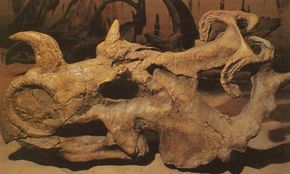CENTROSAURUS (SEN-troh-SORE-us)
Period: Late Cretaceous
Advertisement
Order, Suborder, Family: Ornithischia, Marginocephalia, Ceratopsidae
Location: North America (Canada)
Length: 17 feet (5 meters)
Centrosaurus, which means "sharp-point reptile," was named by Lawrence Lambe in 1902 from specimens found along the Red Deer River in Alberta. A number of complete skulls and skeletons have since been discovered. An entire Centrosaurus herd, ranging in size from juveniles to old adults, was found in a fossil river bed in Dinosaur Provincial Park in southern Alberta. Paleontologists think this herd may have drowned while crossing a flood-swollen river.
Centrosaurus resembled its close relative Monoclonius. Centrosaurus had a long, pointed nasal horn; small bumps over its eyes instead of brow horns; and a short, rounded neck frill with moderately large fenestrae (openings). Monoclonius and Centrosaurus lived at the same time and in the same places. Because they looked alike and because of the poor quality of most Monoclonius specimens, Centrosaurus and Monoclonius have been confused with each other or even considered the same dinosaur. Recent studies have confirmed that they are separate dinosaurs. Part of the proof is the unique paired processes (a hornlike growth) that grew out of the back of the frill of Centrosaurus. One pair of processes were long, grooved, banana-shaped tongues of bone that curved forward and down over the fenestrae. A second pair grew backward and curved toward each other.
Other close relatives of Centrosaurus included Styracosaurus, Pachyrhinosaurus, Brachyceratops, and Avaceratops.
Advertisement
